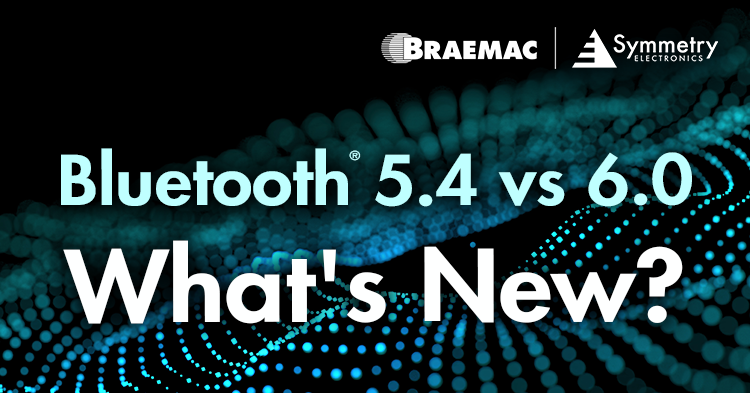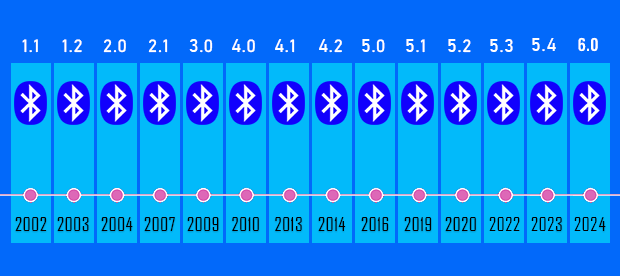- Home
- Braemac Blog
- Exciting New Features of Bluetooth® 6.0
Exciting New Features of Bluetooth® 6.0
About Jari Haiston

In 2024, Bluetooth SIG, Inc. announced their latest core specification, Bluetooth® 6.0. With major advances introduced in their 2023 Bluetooth v5.4 release including Periodic Advertising with Responses (PAwR) and Encrypted Advertising Data, developers can expect an even more powerful and feature-rich experience with v6.0.
.png)
How Often Is a New Bluetooth® Core Specification Released?
The first version of Bluetooth was established in 1999. Since Bluetooth 1.0, Bluetooth SIG has released 13 core specifications every few years. Originally designed by Nokia, Bluetooth® Low Energy (LE) began as part of Bluetooth 4.0 in 2010. Today, it is widely adopted for its convenient low power data transfer properties and, according to Data Bridge Market Research, the global Bluetooth® LE Market is expected to reach $55.75 billion by 2032.
Does Bluetooth® 6.0 Include the Same Features as Bluetooth® 5.4?
With key features of Bluetooth® 5.4 to be specifically geared for the electronic shelf label (ESL) market, many are left wondering whether v6.0 will expand on v5.4 capabilities or whether it is a standalone core specification. Fortunately, Bluetooth® 6.0 incorporates and expands upon the existing features introduced in Bluetooth® 5.4:
Periodic Advertising with Responses (PAwR)
PAwR enables bidirectional communication in connectionless mode by broadcasting structured data in small packets within subevents. PAwR subevents offer defined time slots that end nodes can selectively respond to at the application level. Since nodes only need to briefly scan for specific subevents, PAwR provides a highly power-efficient communication method.
Encrypted Advertising Data
Before Bluetooth® v5.4, Encrypted Advertising Data was only established for connection-oriented communications. An Encrypted Advertising Data solution was driven by the fact that most ESL application data exchanges occur through PAwR. In Bluetooth® v5.4, advertising data can be encrypted in totality or in a more specific subset.
LE GATT Security Level Characteristics
LE GATT SLC helps improve user experience by reducing glitches caused by delayed access security conditions. In Bluetooth® v5.4 developers can determine sufficient security modes and levels upfront.
Advertising Coding Selection
Advertising Coding Selection presents opportunities to control error correction data and increase communication range through S parameters. Hosts can determine specified coding schemes that controllers should use to transmit advertising PDUs.
What Can Developers Expect with Bluetooth® 6.0?
The key features that separate Bluetooth® 6.0 from its predecessors further expand upon Bluetooth® LE application possibilities and support new technological innovation. It delivers major improvements to existing capabilities like advertising and isochronous channels, along with key features tailored for advanced location-based services.
Bluetooth® Channel Sounding is a secure method for precise distance measurement between two enabled devices. This process, known as phased-based ranging (PBR), is beneficial to a wide variety of applications, including digital keys and device-locating services like ‘Find My’ networks. Channel Sounding offers a standardized, technically robust solute on purpose-built for performance, accuracy, and security.
Incorporating a secondary ranging method, round-trip time (RTT), as a method of mitigating man-in-the-middle (MITM) attacks, Channel Sounding delivers inherent advanced security. Moreover, RTT is a distance bounding technique that cross-checks initial PBR measurements, ensuring ultra-accurate measurements.
Decision-Based Advertising Filtering
Decision-based advertising filtering enables a scanning device to evaluate the contents of a packet received on a primary advertising channel before deciding whether to monitor associated packets on secondary channels. This selective approach enhances scanning efficiency by minimizing time spent on secondary channels when the data is unlikely to be relevant to the application.
Monitoring Advertisers
With monitoring advertisers, Host Controller Interfaces (HCI) are utilized to track when devices move in/out of range. Traditionally, observer devices can instruct a Bluetooth® LE controller to suppress duplicate advertising packets. When this type of filtering is active, hosts only receive single packets to improve efficiency.
ISOAL Enhancement
The Isochronous Adaptation Layer (ISOAL) allows larger data frames to be split into smaller packets for transmission, while preserving timing information necessary for proper reassembly by the receiver. Bluetooth® Core 6.0 introduces a new framing mode that reduces latency for time-sensitive applications and also enhances transmission reliability.
LL Extended feature Set
Bluetooth® LE devices can share information about the link layer features they support. As versions have evolved, the number of supported features has grown. The updated specification expands this capability to allow devices to exchange more feature data.
Frame Space Update
Earlier versions of core specifications defined a fixed inter-frame spacing (T_IFS) of 150 microseconds between consecutive packet transmission during a connection event or CIS subevent. With Bluetooth® v6.0, frame space has been updated to improve flexibility between intervals.
Bluetooth® 6.0-Enabled Innovations Available at Braemac Americas
As a global electronics distributor with over 40 years of industry experience, Braemac Americas | Symmetry Electronics has a broad portfolio of cutting-edge innovations that include the latest breakthrough technologies. Explore best-in-class Bluetooth® 6.0- supported solutions from industry-leading suppliers available now at Braemac Americas.
The nRF54L15 from Nordic Semiconductor is a multiprotocol 2.4 GHz radio that supports Bluetooth® 6.0 features including Bluetooth® Channel Sounding, as well as 802.15.4-2020 for standards such as Thread®, Matter, and Zigbee®, and a proprietary 2.4 GHz mode supporting up to 4 Mbps for higher throughput. Key features include:
- 128 MHz Arm Cortex®-M33 processor
- Scalable memory configurations up to 1524 KB NVM and up to 256 KB RAM
- Multiprotocol 2.4 GHz radio supporting Bluetooth Low Energy, 802.15.4-2020, and 2.4 GHz proprietary modes (up to 4 Mbps)
- Comprehensive set of peripherals including new Global RTC available in System OFF, 14-bit ADC, and high-speed serial interfaces
- 128 MHz RISC-V coprocessor
- Advanced security including TrustZone® isolation, tamper detection and cryptographic engine side-channel leakage protection
- Ultra-compact packages
- WLCSP 2.4x2.2 mm
- QFN 6.0x6.0 mm
The EFR32xG24 from Silicon Labs is a Channel Sounding Radio Board Wireless Start Kit (STK). It’s a flexible solution for streamlining SiLabs’ wireless applications. The mainboard features:
- Advanced Energy Monitor
- Packet Trace Interface
- Logic analyzer (BRD4002A only)
- Virtual COM port
- SEGGER J-Link on-board debugger
- External device debugging
- Ethernet and USB connectivity
- Silicon Labs Si7021 relative humidity and temperature sensor
- Low-power 128x128 pixel Memory LCDTFT
- User LEDs / pushbuttons
- 20-pin 2.54 mm EXP header
- Breakout pads for Wireless SoC I/O
- CR2032 coin cell battery support
